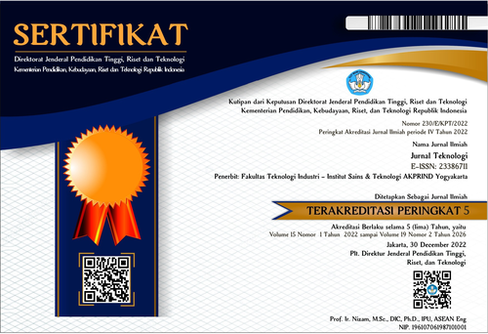Implementasi Radio Frequency Identification (RFID) Untuk Kartu Pasien Berbasis Data Digital
DOI:
https://doi.org/10.34151/jurtek.v15i1.3744Keywords:
Digital Data, Patient Card, RFIDAbstract
Today's technological developments have largely replaced conventional ones. One example is the RFID system. Patient Card is an identification in the form of patient data documents in conventional hospitals. Therefore, with this RFID system, it can contain a security control system both in terms of administration and information technology based on a database in the Hospital. The data is stored in the Patient Card based on digital data. Utilization of digital data-based patient cards to speed up patient services in the registration process during treatment, and reduce queue times when the data identification process is carried out by the patient registration department, as well as the efficiency of human resources. The process of designing tools by initializing the use of tool components. The data processing is carried out by Arduino Nano to read RFID and serial communication to communicate with Arduino UNO as a graphic LCD display. The Arduino Uno processor used detects the card. With the validation of the card, the patient can continue the examination process to the desired poly and exit in the form of a printed queue number according to the destination poly.
Downloads
References
Alief Ridwan, Darjat and Sudjadi (2014). Pemanfaatan Teknologi RFID Melalui Kartu Identitas Dosen Pada Prototipe Sistem Ruang Kelas Cerdas, Jurnal Transmisi, 16,page 63-68
Bannister, F. and Connolly, R. (2007). A Risk Assessment Framework for Electronic Voting, International Journal of Technology, Policy and Management, Vol. 7 No. 2, pp. 190-208.
Ch. Naveed Zafar dan Anthony Pilkjaer. (2007). E Voting in Pakistan, Master Thesis, Lulea Unyversity of Technology, Pakistan.
Everett, S. P., Greene K. K., Byrne, M. D., Wallach, D. S., Derr, K., Sandler, D., dan Torous. (2008). Electronic Machines versus Traditional Methodes : Improved Preference, Similar Performance, Proceedings Measuring, Business and Voting, pp. 883-892.
Hutagalung M.K. (2012). Perancangan Perangkat E-Voting Berbasis E-KTP, Jurnal Saintikom, STMIK Triguna Dharma, Medan.
Kurniawan R. I dan Sujianto. (2013). Efektivitas Implementasi Program e-KTP, Jurnal Administrasi Pembangunan, Volume 1, Nomor 2, Maret 2013, hlm. 101-218.
Lukman M.P and Angriani Husni. (2018). Implementasi Teknologi RFID Pada Sistem Antrian Rekam Medis Pasien di Rumah Sakit, Jurnal Ilmiah Volume 10 Nomor 1, ISSN 2087-1716.
Munir, Agus Qomaruddin.EL Utari, (2016). Pemanfaatan E-KTP Untuk Proses Pemungutan Suara Pemilihan Umum diIndonesia Menggunakan Sistem E-Vote, Seminar Nasional Teknomedia STMIK Amikom Yogyakarta, page 241.
EL Utari, (2016), Analisa Perancangan Alat Simulator Gelombang QRS Sebagai Pengenalan Pola Gelombang Elektrokardiograf, Jurnal Teknoin 22 (1) ,190-201.
Downloads
Published
How to Cite
Issue
Section
License
Copyright (c) 2022 Evrita Lusiana Utari, Irawadi Buyung, Agus Qomaruddin Munir

This work is licensed under a Creative Commons Attribution 4.0 International License.
Jurnal Teknologi provides immediate open access to its content in order of making research freely available to the public to support a global exchange of knowledge. All articles published in this journal are free for everyone to read and download, under licence CC BY SA.
Benefits of open access for the author, include:
- Free access for all users worldwide.
- Authors retain copyright to their work.
- Increased visibility and readership.
- No spatial constraints.




















